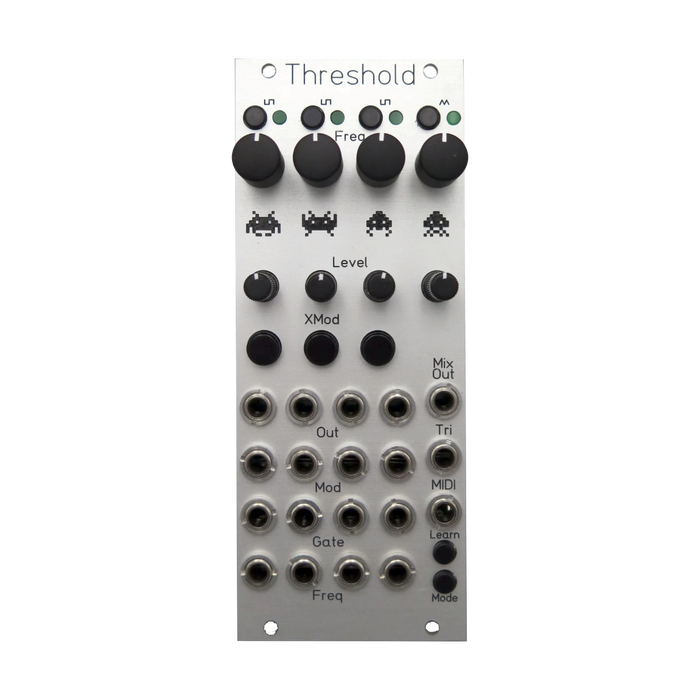Threashold is a compact sound source module that clones Mutable Instruments' chiptune oscillator Edges in 10HP.
Equipped with XNUMX digital oscillatorsSounds like an 8-bit console or home console3 of the oscillators are square waves, and the remaining one is a digital noise by LFSR (linear feedback shift register) or a triangular wave like that used in game consoles.In order to reproduce the classic digital sound, the square wave is generated using digital logic such as timers and counters instead of DSP.Each voice is equipped with a VCA that operates with ON/OFF, and the sound can be controlled only by the gate signal.
Also, the pitch of each channel isbuilt-in sequencerIt is also possible to control withTurning the sequencer ON/OFF and recording the sequence are done in setting mode.It also has a quantizer.See "Setting Mode and Sequence" below for those settings.
Threshold also extends MIDI reception.
HOW TO USE
The roles of each input/output and operator are as follows.
Gate Input
At the gate input of each voice, the VCA opens when a gate signal (0.7V or higher) is input here.Each VCA is a binary VCA with only two types of ON/OFF.Since the gate signal is internally wired to the next channel, the gate signal of the previous channel is connected unless patched.When sequencer mode is ON, the VCA is always ON and the gate input here becomes the sequencer clock input.
Freq Input
This is a pitch input for controlling the pitch of each channel with 1V/Oct.Like the gate signal, the 1V/Oct signal of the previous channel is normalized (internally wired).
Mod Input
Frequency control input for each voice. Works the same as 1V/Oct, but is not internally wired to the next channel.
Freq Knobs
Knobs control the frequency of each channel.The range of adjustment is 6 octaves.
Xmod
This button turns on various cross modulations.From left to right: hard sync on channels 1 and 2/ring modulation on channels 1 and 2/ring modulation on channels 1 and 3.
Oct
Individual channel voice output
Level control
A volume control for each voice sent to the Mix.It does not affect volume to individual channel outputs.
Waveform Select Button
These buttons select the waveform of each channel.
Mix output
The output is a mixture of each voice sound adjusted with the Level knob.
Setting Mode and Sequence
Press and hold the Waveform Select switch of the channel you want to set to enter the setting mode for that channel.
Button 1 toggles quantize ON/OFF for that channel. The 2nd button switches ON/OFF of the sequencer for that channel. The 3rd button is for sequence recording, and the 4th button is for calibration.
To record a sequence, press button 3 and do the following:
- Set the pitch of the first step with the Freq knob of the corresponding channel
- Press the 2nd button to select the 2nd step
- Set the pitch of the second step with the Freq knob on the same channel
- repeat
- After setting the 4th step with the 4th button, the 5th step can be set by pressing the 1st button.
- The same is true for the 6th step onwards.
- At the step where you want to end the sequence, press the button of the same step to end (if it ends in 6 steps, press the 2nd button again after typing).
- Press and hold any of the four buttons to return to normal mode.
Calibration is done as follows after pressing button 4.
- Unplug all jacks and center the Freq knob.
- When the LEDs are lit in the order **oo , send C2 CV (exactly 1V).Press button 4 again when finished.
- Since the LED is ****, send C4 CV (exactly 3V).Press button 4 again when finished.
- Repeat for other channels in the same way.
MIDI Learn Button: When you press this button and then send a MIDI note, the device will use that channel as its base channel.
MIDI Mode Button: This button toggles between two modes of operation:
1. 4 voices are triggered by 4 MIDI channels starting from the base MIDI channel. If the base channel in MIDI Learn is channel 2, the voices are mapped to channels 2, 3, 4, and 5.
2. In Poly mode, each voice plays different notes on the same MIDI channel.






